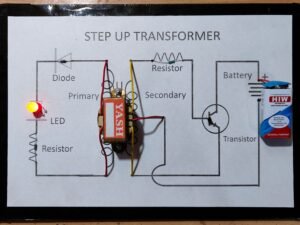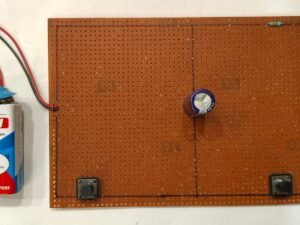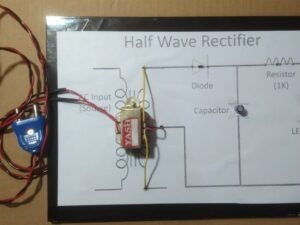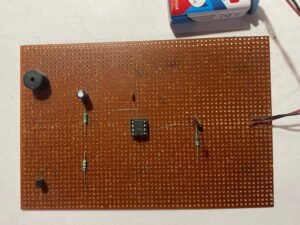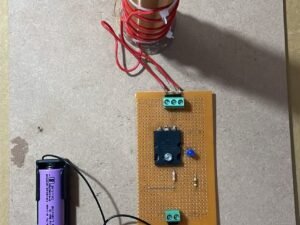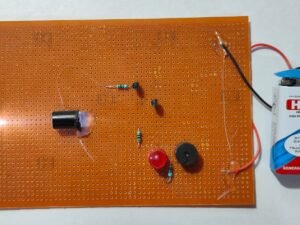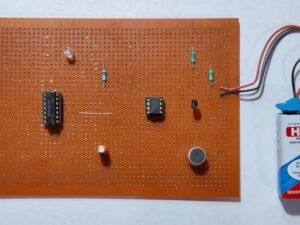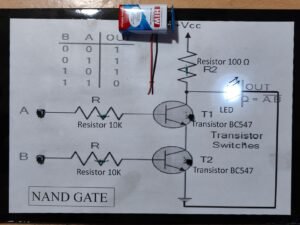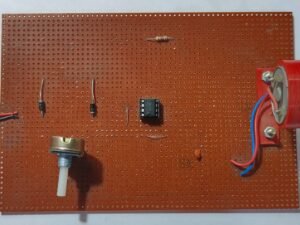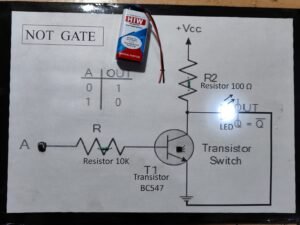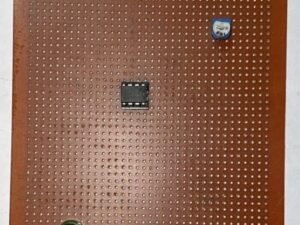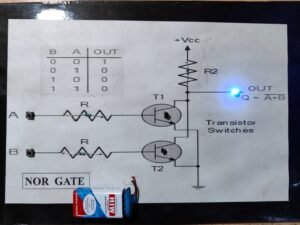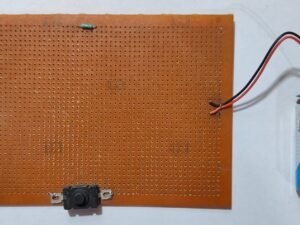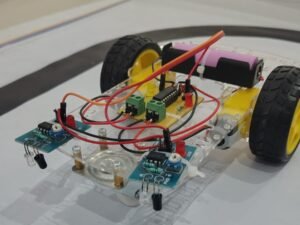Mini Projects
Explore a variety of mini projects to enhance your skills and knowledge in electronics. Start building and learning today!
B.Tech Diploma Mini Projects
Showing 1–24 of 45 resultsSorted by popularity
-
B.Tech Diploma Mini Projects
Working of Capacitor
A capacitor is an electronic component that stores electrical energy in an electric field between two conductive plates. When voltage is applied, charge accumulates on the plates, storing energy. Capacitors are used in various applications, such as filtering, energy storage, voltage regulation, and timing circuits in electronics.
SKU: Working of Capacitor -
B.Tech Diploma Mini Projects
Step Up Transformer
A Step-Up Transformer increases voltage from a lower to a higher level by using two coils: the primary and secondary. The secondary coil has more turns, producing a higher output voltage. This project demonstrates its role in power transmission, reducing energy losses, and applications in electrical devices like microwaves and X-rays.
SKU: Step Up Transformer -
B.Tech Diploma Mini Projects
Step Down Transformer
A Step-Down Transformer reduces high voltage to a lower level using two coils: the primary and secondary. The secondary coil has fewer turns, producing a lower output voltage. This project demonstrates its role in power distribution, delivering safe voltage for homes and devices like chargers, emphasizing energy conversion and electromagnetic principles.
SKU: Step Down Transformer -
B.Tech Diploma Mini Projects
WheatStone Bridge
The Wheatstone Bridge is a circuit used to measure unknown resistance with high precision. It consists of four resistors, a galvanometer, and a variable resistor. By balancing the bridge (no current through the galvanometer), the unknown resistance is calculated. This project highlights its applications in sensors and electrical measurements.
SKU: WheatStone Bridge -
B.Tech Diploma Mini Projects
Working of Capacitor
Click Here to Download the Circuit Diagram of “Working of Capacitor”
Click Here to Download the Synopsis of “Working of capacitor”
The Working of Capacitor project demonstrates how capacitors store and release electrical energy. It involves setting up a simple circuit with a capacitor, resistor, and power source. By charging the capacitor through the resistor and then discharging it, the project shows how capacitors accumulate energy and release it in a controlled manner. The time taken for charging and discharging, observable through an LED or multimeter, illustrates the capacitor’s role in smoothing voltage fluctuations and filtering signals. This hands-on project helps understand the capacitor’s function in electronic circuits and its applications in energy storage and signal processing.
SKU: working-of-capacitor-project-pcb -
B.Tech Diploma Mini Projects
Half Wave Rectifier
Click Here to Download the Circuit Diagram of “Half Wave Rectifier”
A half-wave rectifier converts AC voltage to DC voltage using a single diode. In this project, connect an AC voltage source to the input terminals of a diode, with the anode connected to the positive terminal of the AC source and the cathode to a load resistor. The diode allows current to pass only during the positive half of the AC cycle, blocking the negative half. The output across the load resistor will be a pulsating DC signal, representing only the positive half of the input AC waveform. This setup demonstrates the basic principle of rectification and provides insight into the function of diodes in power supplies.
SKU: half-wave-rectifier-project -
B.Tech Diploma Mini Projects
Full Wave Rectifier
A Full Wave Rectifier converts alternating current (AC) into direct current (DC) by utilizing both halves of the AC waveform. Using a transformer and diodes in a bridge or center-tap configuration, it ensures efficient conversion with reduced power loss. This project is fundamental for learning power supply and rectification techniques.
SKU: Full Wave Rectifier -
B.Tech Diploma Mini Projects
Fire Alarm Using Thermistor and IC 555
The Fire Alarm using a Thermistor detects temperature changes. As heat rises, the thermistor’s resistance drops, triggering the alarm. It’s a simple, cost-effective way to enhance safety in homes and offices by providing early warnings of potential fire hazards.
SKU: fire-alarm-using-thermistor-project -
B.Tech Diploma Mini Projects
Tesla Coil
The Tesla Coil project demonstrates wireless transmission of high-voltage electricity using a 2SC5200 transistor, a 3.7V battery, and copper coils. The primary coil generates a magnetic field, inducing voltage in the secondary coil. This creates a spark or lights up nearby objects wirelessly, showcasing electromagnetic induction and high-frequency resonance principles.
SKU: Tesla Coil -
B.Tech Diploma Mini Projects
Security Alarm System
A Security Alarm System is designed to detect unauthorized entry and alert users of potential security breaches. It typically includes sensors (such as motion detectors, door/window contacts), an alarm unit (sound or notification system), and control panels for monitoring and managing the system. Integrated with communication features like GSM or Wi-Fi, it provides real-time alerts and remote monitoring, enhancing security for homes, businesses, and other properties.
SKU: security-alarm-system-project -
B.Tech Diploma Mini Projects
Car Turning Indicator
Click Here to Download the Circuit Diagram of “Car Turning Indicator”
The Car Turning Indicator project provides visual signals to indicate a vehicle’s turning or lane change. Using a set of LEDs or bulbs and a control circuit, such as a relay or electronic flasher, the system activates the appropriate lights on the car. This project enhances road safety by making the vehicle’s intentions clear to other drivers.
SKU: car-turning-indicator-project -
B.Tech Diploma Mini Projects
Clap Switch LED On/Off Using IC 555
Click Here to Download the Circuit Diagram of “Clap Switch Led On Off”
The Clap Switch LED On/Off project controls an LED based on sound detection. Using a sound sensor or microphone and a relay or transistor, the circuit toggles the LED’s state with each clap. This project demonstrates basic sound-to-action control, providing a hands-free method to operate an LED.
SKU: clap-switch-led-on-off -
B.Tech Diploma Mini Projects
NAND Gate
Click Here to Download the Circuit Diagram of “NAND Gate”
Discover our NAND Gate project, a fundamental building block in digital electronics. Learn how to construct and apply this versatile logic gate in various circuits, essential for creating more complex digital systems. Perfect for students and hobbyists looking to deepen their understanding of logic gates and digital design.
SKU: nand-gate-project -
B.Tech Diploma Mini Projects
DC Motor Speed Control
Click Here to Download the Circuit Diagram of “DC Motor Speed Control”
The DC Motor Speed Control project adjusts the speed of a DC motor using a variable resistor or Pulse Width Modulation (PWM) signal. By varying the voltage or duty cycle applied to the motor, you can control its rotational speed. This project demonstrates motor control techniques, providing practical experience in adjusting motor performance for various applications.
SKU: dc-motor-speed-control-project -
B.Tech Diploma Mini Projects
NOT Gate
Click Here to Download the Circuit Diagram of “NOT Gate”
Learn about our NOT Gate project, a fundamental logic gate in digital electronics. Discover how to build and apply this inverter gate, which flips input signals from high to low or vice versa. Perfect for students and enthusiasts exploring the basics of logic circuits and digital design.
SKU: not-gate-project -
B.Tech Diploma Mini Projects
IR Proximity Sensor
The IR Proximity Sensor Circuit uses an IR LED, photodiode, and LM358 operational amplifier to detect nearby objects. The IR LED emits light, which reflects off objects and is detected by the photodiode. The LM358 amplifies the signal, triggering an LED indicator, powered by a battery with a current-limiting resistor.
SKU: IR Proximity Sensor -
B.Tech Diploma Mini Projects
Dark Sensor Using LDR
Click Here to Download the Circuit Diagram of “Dark Sensor Using LDR”
The Dark Sensor using an LDR (Light Dependent Resistor) detects low light conditions to trigger an output action, such as turning on an LED or activating a relay. The LDR changes resistance based on ambient light levels, which is used to control the circuit, making it ideal for automatic lighting systems and light-sensitive applications.
SKU: dark-sensor-project -
B.Tech Diploma Mini Projects
NOR Gate
Click Here to Download the Circuit Diagram of “NOR Gate”
Discover our NOR Gate project, a crucial element in digital electronics. Learn how to build and apply this logic gate, which outputs true only when all its inputs are false. Ideal for students and enthusiasts interested in mastering logic circuits and understanding the fundamentals of digital design.
SKU: nor-gate-project -
B.Tech Diploma Mini Projects
Transistor as Switch
Click Here to Download the Circuit Diagram of “Transistor as Switch”
The Transistor as a Switch project demonstrates how a transistor can control a high-current load with a low-current signal. In this setup, the transistor acts as an electronic switch, using its ability to amplify current to turn a load on or off.
Components:
- NPN Transistor (e.g., BC547)
- Resistor (base resistor)
- Load (e.g., LED with current-limiting resistor)
- Power Supply
Working:
- Base Resistor: Connects the transistor’s base to a control signal (e.g., a microcontroller or a switch). This resistor limits the base current.
- Collector-Emitter Path: The load is connected between the collector of the transistor and the power supply. When the transistor is in the “on” state (saturated), current flows from the collector to the emitter, powering the load.
- Control Signal: Applying a small voltage to the base allows a larger current to flow from the collector to the emitter, thus switching the load on.
When the control signal is high, the transistor conducts, and the load is energized. When the control signal is low, the transistor stops conducting, and the load turns off. This simple yet effective project showcases the transistor’s utility in switching applications.
SKU: transistor-as-switch-project -
B.Tech Diploma Mini Projects
Temperature Controlled DC Fan
A Temperature Controlled DC Fan circuit adjusts fan speed based on temperature variations. Using a temperature sensor and a DC motor driver, it regulates fan operation to maintain a desired temperature. This circuit helps in efficient cooling by automatically increasing or decreasing fan speed as temperature changes, enhancing energy efficiency.SKU: temperature-controlled-dc-fan-project -
B.Tech Diploma Mini Projects
Simple Led On Off Circuit
A Simple LED On/Off Circuit is a basic electronic circuit designed to control the state of an LED (Light Emitting Diode) using a switch. It typically consists of an LED, a resistor, a switch, and a power source. The resistor limits the current flowing through the LED to prevent damage. When the switch is closed, current flows through the circuit, causing the LED to light up. When the switch is open, the circuit is broken, and the LED turns off. This straightforward circuit is often used for learning and testing purposes, as well as in various simple electronic projects.
SKU: simple-led-on-off-circuit-project -


